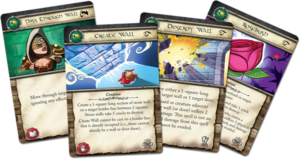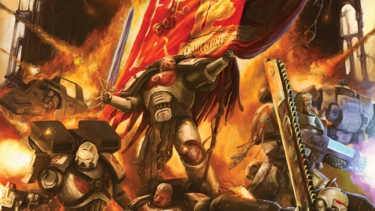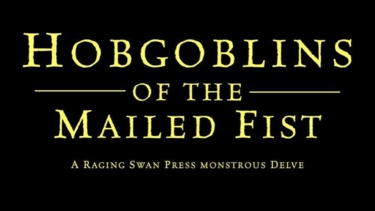
Publisher: Fantasy Flight Games
Designer: Tom Jolly, Kevin Wilson
Year: 2012
Genre: Fantasy game of dueling wizards
Players: Two to four players
Ages: 14+
Playing Time: 60 Minutes
MSRP: $49.95
Wiz-War was originally developed by Tom Jolly in 1983. This most recent incarnation from Fantasy Flight Games is the Eighth Edition of the game, which would indicate that it is probably a pretty good game, and it is.
I’ve never played Wiz-War before. Oh, I’ve seen it around in its many forms, but this is the first chance I’ve had to actually play the game. The premise is simple; a couple of wizards get together in a labyrinth to duel. The first wizard to either gain two victory points or kill all of the other wizards wins the game. Victory points can be gained by either killing another wizard, or by stealing one of their treasures and bringing it back to your home square.
The components are of the same high quality I have come to expect from FFG. The figures are nicely detailed and scream 
One note about the figures, each wizard is interchangeable with the four colors. The colored base pops off and you can put any wizard figure into it. This is cool because some cards allow your wizard to transform into another form. The game comes with five other figures that you can turn into if you cast the right spell. You can become a werewolf, or a slime monster, a golem, a gnome, or a big dude. Each form has its benefits and problems, and it is a pretty cool thing to be able to do.

The selected cards are shuffled together to form the magic deck for the game, each player is dealt five cards as their starting hand, and you are ready begin by randomly choosing a starting player to take the first turn.
A turn has of three phases. The first is the Time Passes phase, in which you remove an energy token from all of the spells you are maintaining in front of you, remove a stun token if you are stunned, and resolve any ongoing spell effects.
The second phase is where the action is. This is the movement and spell casting phase. A wizard may move up to three squares orthogonally, unless they are in some form which gives them extra movement. You can increase this by discarding a magic card with an energy value printed on it. This will boost your movement by that energy amount for this turn. You can also cast spells, which come in different flavors.
Attack spells allow you to attack another wizard. You may make one attack per turn, unless a card allows you to make more. You may cast as many neutral and item spells as you wish. Energy spells are used to boost the strength of other spells, and counter spells are played against other wizards during their turn. Spells have different durations, and different target types. Many must be made in line of sight of the wizard being attacked.
The third phase is the discard and draw phase. You can draw up to two cards, but you can never have more than seven, and this includes cards that you have played in front of you as items that you are carrying or spells that you are maintaining.
I’m not going to go into all of the rules here. They are not complex, but there are many small interactions between cards that take a bit of interpretation. For the most part these are covered in the rules, and there is an FAQ available on the FFG website for some of the more specific tricky card interactions.
Instead, I’ll tell you about the final round of the last game I played against my son Matt. I had him down to four life points, while I was sitting at 14. Each wizard starts with 15, and there are these neat life counter dials to keep track of it. On a side note, these dials actually go all the way up to 20, making them suitable for use in another popular dueling wizard card game I know of.
Back to the story, my son had one of my treasures in his home square giving him one victory point. I was carrying my 
Matt then cast a spell to make me drop the treasure I was carrying. He picked up the treasure, which basically ended his turn. I started my turn right next to him. I could have stabbed him with my dagger, or thrown a large rock at him, but instead I cast a powerthrust, which would take him down to -1 life. Matt had a counter spell though, and deflected my powerthrust with ease. I was doomed, as that was my one attack for the turn. Matt simply ran into his home square with my second treasure on his next turn, and won the game. The moral of the story? Next time, just throw a big rock.
The game is fun. It is not an intense strategy game, it’s meant to be fun more than anything else. There is strategy involved, and some planning to do, and spell combos to attempt. A lot depends on the luck of the draw, with the right cards and planning it is possible to take out an enemy wizard in a single attack. I haven’t had it happen yet, but it is possible. It’s cool though as it is a fairly short game, and it is meant to be a good time. There is player elimination, but again most games are less than an hour, sometimes 30 minutes, once everyone knows how to play.
My only source of annoyance with Wiz-War is that you have to separate the cards back into their respective schools once the game is over. I’m debating on trying to play the game with each school in a separate draw pile, and allowing the players to draw from whatever pile they wish. This would cut down on the sorting time once the game is over; I’m just not sure how it would affect game play until I try it out.
Wiz-War is a fun time regardless of the number of players. The more the merrier of course, but since this is a direct confrontation game I would avoid playing with younger and more sensitive gamers. Overall, I liked it a lot, and I’m hoping for some expansions in the future.
- A Dungeon Delve for Kids?: A Review of Dungeon! - Oct 24, 2022
- Better, Stronger, Faster | Descent: Journeys in the Dark Second Edition Reviewed - Oct 23, 2022
- Your Planet is Doomed!: Invasion from Outer Space Reviewed - Oct 22, 2022












